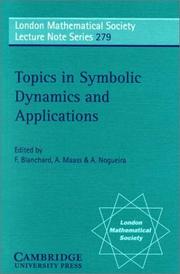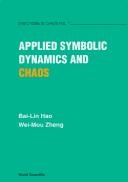| Listing 1 - 10 of 24 | << page >> |
Sort by
|

ISBN: 3540674349 Year: 2000 Publisher: Berlin ; Heidelberg ; New York Springer Verlag
Abstract | Keywords | Export | Availability | Bookmark
 Loading...
Loading...Choose an application
- Reference Manager
- EndNote
- RefWorks (Direct export to RefWorks)
Book
ISBN: 1470479559 Year: 2024 Publisher: Providence, RI : American Mathematical Society,
Abstract | Keywords | Export | Availability | Bookmark
 Loading...
Loading...Choose an application
- Reference Manager
- EndNote
- RefWorks (Direct export to RefWorks)
Book
ISBN: 0511626304 Year: 1995 Publisher: Cambridge : Cambridge University Press,
Abstract | Keywords | Export | Availability | Bookmark
 Loading...
Loading...Choose an application
- Reference Manager
- EndNote
- RefWorks (Direct export to RefWorks)
Symbolic dynamics is a rapidly growing area of dynamical systems. Although it originated as a method to study general dynamical systems, it has found significant uses in coding for data storage and transmission as well as in linear algebra. This book is the first general textbook on symbolic dynamics and its applications to coding. It will serve as an introduction to symbolic dynamics for both mathematics and electrical engineering students. Mathematical prerequisites are relatively modest (mainly linear algebra at the undergraduate level) especially for the first half of the book. Topics are carefully developed and motivated with many examples. There are over 500 exercises to test the reader's understanding. The last chapter contains a survey of more advanced topics, and there is a comprehensive bibliography.
Book
ISBN: 1108901964 1108899722 Year: 2021 Publisher: Cambridge : Cambridge University Press,
Abstract | Keywords | Export | Availability | Bookmark
 Loading...
Loading...Choose an application
- Reference Manager
- EndNote
- RefWorks (Direct export to RefWorks)
Symbolic dynamics is a mature yet rapidly developing area of dynamical systems. It has established strong connections with many areas, including linear algebra, graph theory, probability, group theory, and the theory of computation, as well as data storage, statistical mechanics, and C^*-algebras. This Second Edition maintains the introductory character of the original 1995 edition as a general textbook on symbolic dynamics and its applications to coding. It is written at an elementary level and aimed at students, well-established researchers, and experts in mathematics, electrical engineering, and computer science. Topics are carefully developed and motivated with many illustrative examples. There are more than 500 exercises to test the reader's understanding. In addition to a chapter in the First Edition on advanced topics and a comprehensive bibliography, the Second Edition includes a detailed Addendum, with companion bibliography, describing major developments and new research directions since publication of the First Edition.

ISBN: 1139885677 1107103878 1107089492 1107092582 1107101379 1107095794 0511758952 9781107089495 9780511758959 9781107095793 0521796601 9780521796606 9781139885676 9781107103870 9781107092587 9781107101371 Year: 2000 Volume: 279 Publisher: Cambridge : Cambridge University Press,
Abstract | Keywords | Export | Availability | Bookmark
 Loading...
Loading...Choose an application
- Reference Manager
- EndNote
- RefWorks (Direct export to RefWorks)
This book, first published in 2000, is devoted to developments in symbolic dynamics and comprises eight chapters. The first two are concerned with the study of symbolic sequences of 'low complexity', the following two introduce 'high complexity' systems. Chapter five presents results on asymptotic laws for the random times of occurrence of rare events. Chapter six deals with diophantine problems and combinatorial Ramsey theory. Chapter seven looks at the dynamics of symbolic systems arising from numeration systems, and finally chapter eight gives a complete description of the symbolic dynamics of Lorenz maps.
Symbolic dynamics. --- Dynamics, Symbolic --- Differentiable dynamical systems --- Symbolic dynamics
Book
ISBN: 0198596855 9780198596851 Year: 1991 Publisher: Oxford: Oxford university press,
Abstract | Keywords | Export | Availability | Bookmark
 Loading...
Loading...Choose an application
- Reference Manager
- EndNote
- RefWorks (Direct export to RefWorks)
Ergodic theory. Information theory --- Symbolic dynamics --- Geometry, Hyperbolic

ISBN: 997150698X 9789971506988 Year: 1989 Publisher: Singapore: World scientific,
Abstract | Keywords | Export | Availability | Bookmark
 Loading...
Loading...Choose an application
- Reference Manager
- EndNote
- RefWorks (Direct export to RefWorks)
Book
ISBN: 9781470437619 Year: 2019 Publisher: Providence, RI : American Mathematical Society,
Abstract | Keywords | Export | Availability | Bookmark
 Loading...
Loading...Choose an application
- Reference Manager
- EndNote
- RefWorks (Direct export to RefWorks)
Topological dynamics --- Symbolic dynamics --- Dynamique topologique --- Dynamique symbolique --- Dynamics. --- Interpolation.

ISBN: 9810235127 Year: 1998 Volume: 7 Publisher: Singapore ; River Edge, NJ : World Scientific,
Abstract | Keywords | Export | Availability | Bookmark
 Loading...
Loading...Choose an application
- Reference Manager
- EndNote
- RefWorks (Direct export to RefWorks)
Symbolic dynamics. --- Chaotic behavior in systems --- Dynamique symbolique --- Chaos
Book
ISBN: 1470473232 Year: 2023 Publisher: Providence, RI : American Mathematical Society,
Abstract | Keywords | Export | Availability | Bookmark
 Loading...
Loading...Choose an application
- Reference Manager
- EndNote
- RefWorks (Direct export to RefWorks)
"In topological dynamics, the Symbolic Extension Entropy Theorem (SEET) (Boyle and Downarowicz, 2004) describes the possibility of a lossless digitalization of a dynamical system by extending it to a subshift on finitely many symbols. The theorem gives a precise estimate on the entropy of such a symbolic extension (and hence on the necessary number of symbols). Unlike in the measure-theoretic case, where Kolmogorov-Sinai entropy serves as an estimate in an analogous problem, in the topological setup the task reaches beyond the classical theory of measure-theoretic and topological entropy. Necessary are tools from an extended theory of entropy, the theory of entropy structures developed in Downarowicz (2005). The main goal of this paper is to prove the analog of the SEET for actions of (discrete infinite) countable amenable groups: Let a countable amenable group G act by homeomorphisms on a compact metric space X and let MG(X) denote the simplex of all G-invariant Borel probability measures on X. A function EA on MG(X) equals the extension entropy function h[pi] of a symbolic extension [pi] : (Y,G) [arrow] (X,G), where h[pi]([mu]) [equals] sup{hV(Y,G) : V [element of] [pi]-1([mu])} ([mu] [element of] MG(X)), if and only if EA is a finite affine superenvelope of the entropy structure of (X,G). Of course, the statement is preceded by the presentation of the concepts of an entropy structure and its superenvelopes, adapted from the case of Z-actions. In full generality we are able to prove a slightly weaker version of SEET, in which symbolic extensions are replaced by quasi-symbolic extensions, i.e., extensions in form of a joining of a subshift with a zero-entropy tiling system. The notion of a tiling system is a subject of several earlier works (e.g. Downarowicz and Huczek (2018) and Downarowicz, Huczek, and Zhang (2019)) and in this paper we review and complement the theory developed there. The full version of the SEET (with genuine symbolic extensions) is proved for groups which are either residually finite or enjoy the so-called comparison property. In order to describe the range of our theorem more clearly, we devote a large portion of the paper to studying the comparison property. Our most important result in this aspect is showing that all subexponential groups have the comparison property (and thus satisfy the SEET). To summarize, the heart of the paper is the presentation of the following four major topics and the interplay between them: Symbolic extensions, Entropy structures, Tiling systems (and their encodability), The comparison property"--
Group actions (Mathematics) --- Symbolic dynamics. --- Topological entropy. --- Tiling (Mathematics)
| Listing 1 - 10 of 24 | << page >> |
Sort by
|

 Search
Search Feedback
Feedback About UniCat
About UniCat  Help
Help News
News